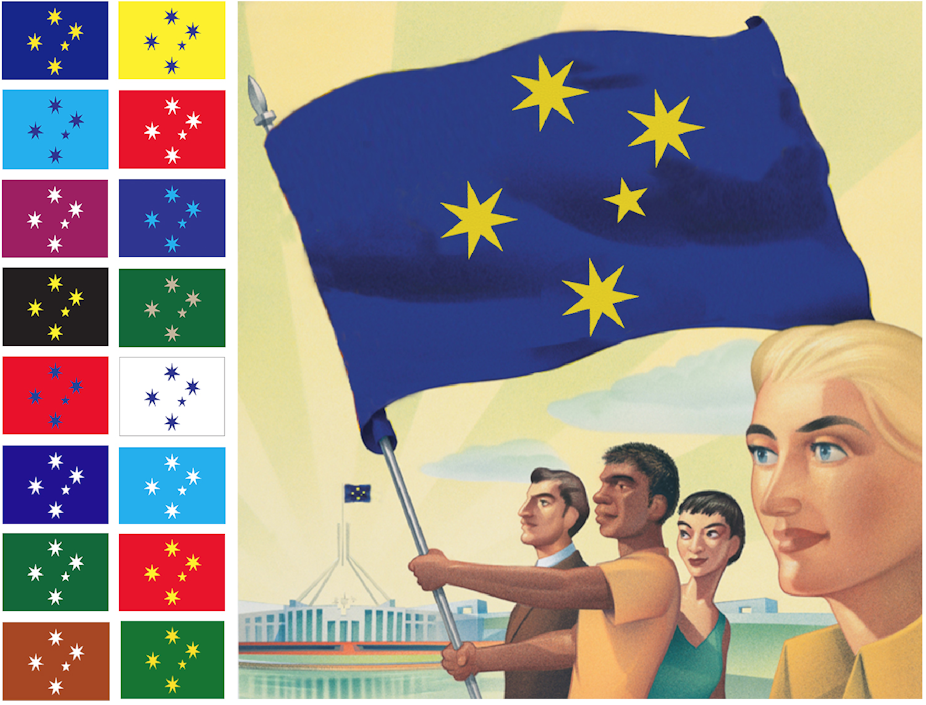Recently on The Conversation, military historian John Blaxand put forward a design proposal for a new Australian flag. This was in light of a call by New Zealand Prime Minister John Key for a “post-colonial” flag and the September independence referendum in Scotland that may lead to the end of the Union Jack.
Having also written for The Conversation about the important design considerations for a national flag, and given the mixed reception to Blaxand’s proposal, I’d like make a case for my own design of the Australian flag (main image) which is the result of my involvement with this national symbol over the past 25 years.
Crux Australia (the constellation commonly known as the Southern Cross) has long been touted as worthy of stand-alone status on the Australian flag. Since its creation, the Eureka Flag has regularly been cited as an alternative national flag although many argue it is too closely aligned with political division.
In 1991, after receiving thousands of submissions, the apolitical lobby group Ausflag proposed a new Australian flag that featured a white Southern Cross constellation on a blue field (see below). Although the suggestion was well publicised it lead to renewed discussion, revised iterations and more design submissions from the general public that led nowhere.

Former Australian PM Paul Keating famously stated in his 1992 Redfern speech:
It is a test of our self-knowledge; of how well we know the land we live in. How well we know our history. How well we recognise the fact that, complex as our contemporary identity is, it cannot be separated from Aboriginal Australia.
Indigenous recognition is very much at the heart of the flag issue.
Flag changes do not happen by osmosis. Change needs to be driven by leaders who appreciate the value of design and understand the importance of representing an authentic, accurate and relevant national identity.
Nelson Mandela understood the power of symbols when he changed the national flag in 1994 to forge a new beginning for South Africa. Twenty years earlier Canadian Prime Minister Lester B. Pearson also demonstrated leadership and vision by instigating the process of changing the Canadian national flag in 1964.

In coming years Australians will participate in a referendum to change the Australian Constitution so that it formally acknowledges Indigenous peoples pre-occupation of the Australian continent.
The fact the current Australian flag only references a colonial history is, and will continue to be, an obstacle to achieving reconciliation in this country.
The Union Jack is viewed by many Aboriginal and Torres Stait Islander people as a symbol of invasion, whereas a national flag should aim to represent unity. To feature the flag of another country on the Australian national symbol in 2014 to me seems subservient and illogical, projecting an image that contradicts the contemporary understanding of Australia, a country that is self-assured, diverse, vibrant and multicultural.
That does not necessarily mean Aboriginal motifs or iconography should appear in a new flag design. What is required is a unifying symbol that resonates with both Indigenous and non-Indigenous Australians.
Advance Australia
In 1999 I designed a new Australian flag titled: Advance Australia.

The Advance Australia design was supported by Ausflag’s public research, which suggested that the kangaroo and the Southern Cross were the most popular symbols to appear on a new flag design.
Here, the Union Jack is replaced with a blue kangaroo, which animates in a forward-moving, bounding motion when flying in the breeze. The yellow area represents the sun and is a link to the Aboriginal flag.
The kangaroo is a quintessential Australian icon (and one of the few animals that physically cannot move backwards). But 15 years after designing Advance Australia I now believe the Southern Cross is the right symbol for the new Australian flag and the most likely to be accepted.
The design proposal
I think the 1991 Ausflag design should be revisited. I believe it would have a strong chance for public acceptance because it features an established, preexisting image.
The Ausflag design has not added elements, it has simply removed the problematic Union Jack. This flag has a strong, recognisable and symmetrical design which can be supported by a genuine unifying claim that people have lived under the Southern Cross in Australia for between 40,000 and 70,000 years.

My suggestion is to change the colours of the stars from white to yellow is linked to the Aboriginal flag. The blue is retained as a link to the current Australian flag and Torres Strait Island flag. Blue and yellow were also the original colours of the Australian coat of arms.
I also propose this flag could form the template for state, territory and other supporting ensigns, which are currently also colonial flags.

The above design proposal suggests that supporting ensigns would all share the same design as the national flag as a statement of unity. Diversity would be represented through traditional colour variations.
Supporting unity, diversity and a link to the long and diverse history of Australia are the primary narratives I’ve attempted to express in this new national flag system.
It would be good to read your views below.
Further reading:
What are you waving that Aussie flag for?
A proposal for a new, mature Australian flag
Where would the Union Jack’s demise leave the Aussie flag?

